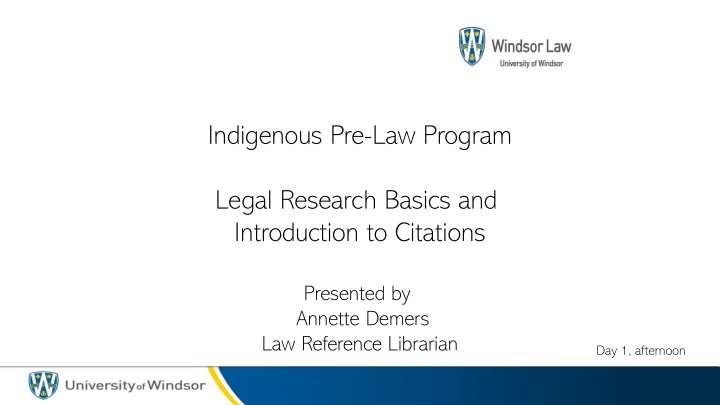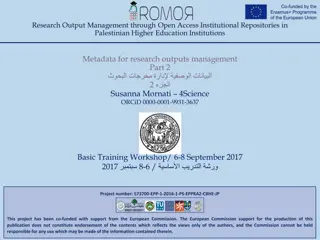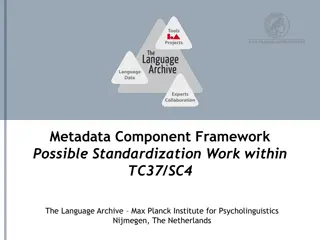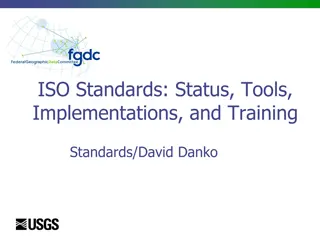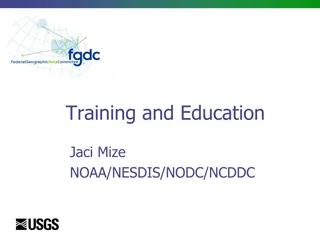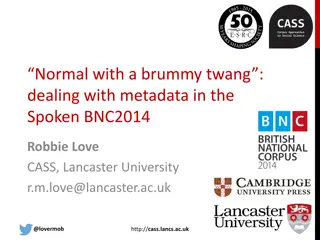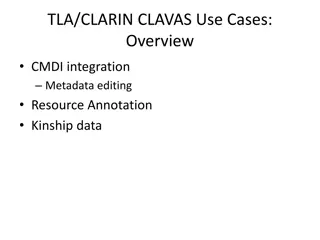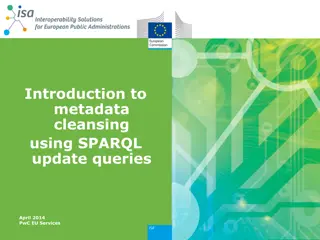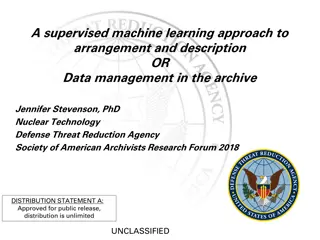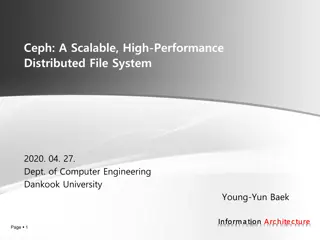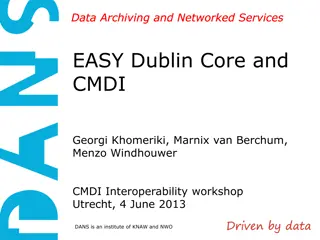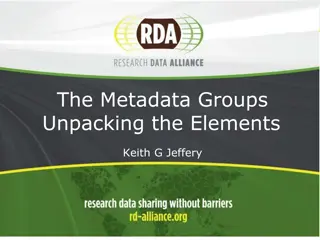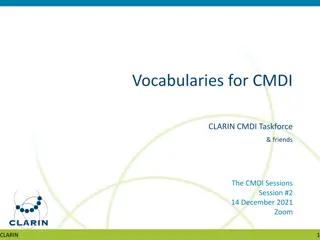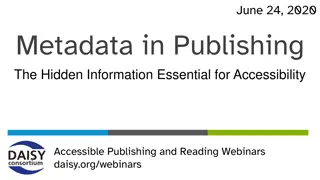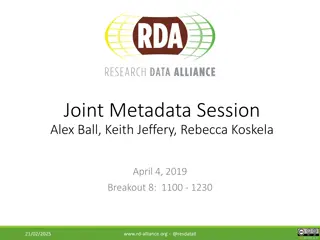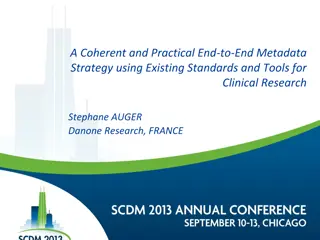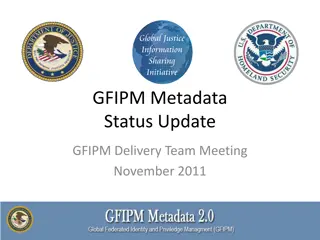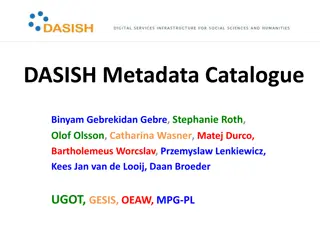Introduction to Metadata and CMDI Workshop
This workshop provides an in-depth look into metadata and the CLARIN Metadata Infrastructure (CMDI), including hands-on practice sessions. Topics covered include the use of ISOCat within CMDI, the CMDI Component Registry, ARBIL metadata editor, standard metadata components, and more. Participants will have the opportunity to create metadata scenarios and engage in practical exercises. The session aims to enhance understanding and application of CMDI in research and data management.
Uploaded on Mar 21, 2025 | 0 Views
Download Presentation

Please find below an Image/Link to download the presentation.
The content on the website is provided AS IS for your information and personal use only. It may not be sold, licensed, or shared on other websites without obtaining consent from the author.If you encounter any issues during the download, it is possible that the publisher has removed the file from their server.
You are allowed to download the files provided on this website for personal or commercial use, subject to the condition that they are used lawfully. All files are the property of their respective owners.
The content on the website is provided AS IS for your information and personal use only. It may not be sold, licensed, or shared on other websites without obtaining consent from the author.
E N D
Presentation Transcript
Indigenous Pre-Law Program Legal Research Basics and Introduction to Citations Presented by Annette Demers Law Reference Librarian Day 1, afternoon
July 30, 2024 1 pm 2 pm Research Sources Legal Research Process Legal Citation Apply what you ve learned
Objectives for this Section Understand research sources Understand the legal research process Spot legal citations Use and reproduce legal citations
Research Sources - Primary Sources Always organized by jurisdiction Term Meaning Examples Tools Sources for the law itself Constitutions Statutes Regulations Judicial Decisions CanLII (all Canadian Jurisdictions) Justice Laws (federal statutes and regs) E-Laws (Ontario statutes and regs) SCC Lexums (SCC decisions) Westlaw Lexis Primary Source
Research Sources - Secondary Sources Term Meaning Examples Tools Secondary source Sources for commentary and analysis about the law Encyclopedias of law Legal dictionaries Books Journal articles Forms and Precedents Practice materials Library Catalogue CanLII Connects HeinOnline Westlaw Lexis+
Citation Basics Legal Citations are important for locating statutes, regulations and judicial decisions. For case law For case law: Provide the party names, jurisdiction, date of decision, level of court and other information. For statutes and regs For statutes and regs: Provide the title of the Act or regulation, the jurisdiction and other information. So, they must be accurately reproduced in your written submissions to the courts and for any other purpose. Tool: Tool: McGill Law Journal, Canadian Guide to Uniform Legal Citation, 10th ed (Toronto, ON: Thomson Reuters, 2023), online: https://ca01.primo.exlibrisgroup.com/permalink/01UTON_UW/1iq68s6/alma9911 84221902181
Case Citation Example: Iris Technologies Inc. v Canada, 2024 SCC 24. Explanation: Iris Technologies Inc. v Canada, Party Names (style of cause) Neutral citation 2024 SCC 24 2024 SCC 24 Year of Decision Level of Court (Supreme Court of Canada) Document number.
Statute Citation Example: Criminal Code, RSC 1985, c C-46. Explanation: Criminal Code RSC 1985 c C-46. Title of Act Abbreviation for Revised Statutes of Canada (include jurisdicti on federal) Year of last revision short form for "chapter" Chapter number.
Statute Citation Example: Animal Health Act, 2009, SO 2009, c 31. Explanation: Animal Health Act, 2009 SO 2009 c 31. Title of Act Abbreviation for Statutes of Ontario (include jurisdicti on Ontario) Year of enactment short form for "chapter" Chapter number.
The Basic Research Process Review client facts and evidence. Review secondary sources. Is the matter statute or common-law based? If statute based, locate current consolidation of statute and any regulations. If common-law based,locate relevant case law. Note up all case law.
Lets Try the Research Process! Locating Secondary Sources. The "Why": The "Why": Articling principles will often ask student researchers to find case law relevant to the client's matter. This is the crux of most research projects. This is where secondary sources can assist. They often summarize law for us and provide footnotes to relevant cases.
Lets Try it! Locating Secondary Sources. To Do: To Do: Look at the facts sheet from this morning. Review the fact and issue questions that you drafted. From these, what are three key terms that we could use to search for secondary sources that could summarize this area of law?
Key Terms liability and (highway or road) and (pony or horse)
Lets Try it! Using the CED. Using the Canadian Encyclopedic Digest part our online subscription to Westlaw Edge Canada. *the CED is just one of the many secondary sources of legal information -great to start with but do not cite to (instead go to the sources it references)
You Try it! Using CanLII Use CanLII https://www.canlii.org/en/ Locate: Rowe v Canning, 1994 CanLII 4474, 117 Nfld & PEIR 353 (Nfld SC (TD)).
You Try it! Deconstructing a Case - Worksheet Rowe v Canning, 1994 CanLII 4474, 117 Nfld & PEIR 353 (Nfld SC (TD)).
Summary Understand research sources Understand the legal research process Spot legal citations Use and reproduce legal citations
Annette Demers ademers@uwindsor.ca Ask for me at the law library!
